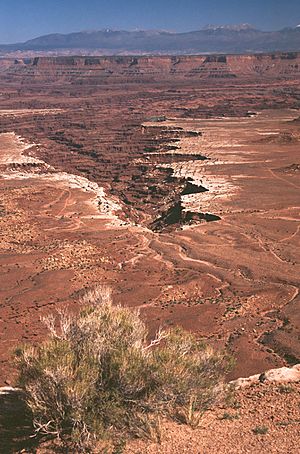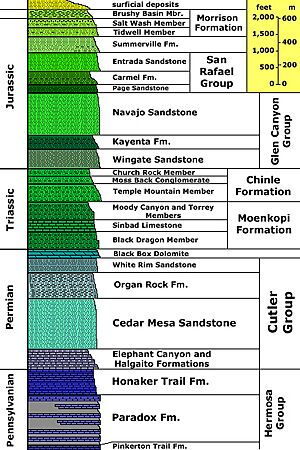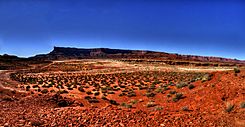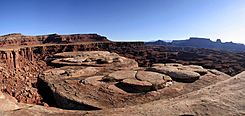White Rim Sandstone facts for kids
Quick facts for kids White Rim SandstoneStratigraphic range: Early to Middle Permian 275–272Ma |
|
|---|---|

White Rim Sandstone, Canyonlands National Park
|
|
| Type | Geological formation |
| Unit of | Cutler Formation |
| Underlies | Kaibab Formation, Circle Cliffs, Utah |
| Overlies | Organ Rock Formation, southeast Utah; Organ Rock and Toroweap Formation, Circle Cliffs |
| Thickness | 500 feet (150 m) approximate maximum |
| Lithology | |
| Primary | (white)-sandstone |
| Location | |
| Region | central & east-Colorado Plateau south and southeast Utah |
| Extent | Circle Cliffs, west of Waterpocket Fold; Moab Utah region |
The White Rim Sandstone is a special type of sandstone rock layer found in southeastern Utah. It's known for its bright white color, which makes it stand out as it forms the edges of tall cliffs. This rock layer is the very last part of a larger group of rocks called the Permian Cutler Group. It sits on top of other rock layers like the Organ Rock Formation and Cedar Mesa Sandstone.
Contents
What is the White Rim Sandstone?
The White Rim Sandstone is a rock layer that formed on land a very long time ago, during the Early to Middle Permian Period. This was a time when ancient seas moved back and forth across the land. As the seas came and went, they left behind sand that eventually hardened into this white sandstone.
How does it relate to other rock layers?
At the same time the White Rim Sandstone was forming, another similar rock layer called the Toroweap Formation was being laid down. The Toroweap Formation formed in ocean water along the southwestern part of North America. You can find it in northwest Arizona, often between the Coconino Sandstone and the Kaibab Formation. The Toroweap Formation is mostly seen in the Grand Canyon area. However, it also appears in some parts of southeast Utah, where it was later covered by the Kaibab Formation.
Where can you find the White Rim Sandstone?
The White Rim Sandstone usually sits above the Organ Rock Formation in southeast Utah. The Organ Rock Formation, in turn, rests on top of the large Cedar Mesa Sandstone layer.
Places to see it in Utah
You can find the White Rim Sandstone in several cool places in Utah:
- Moab, Utah: This city is in southeast Utah, not far from the Colorado border. The White Rim Sandstone is a common sight around here.
- Circle Cliffs: These cliffs are about 90 miles (145 km) southwest of Moab. They are part of the Grand Staircase-Escalante National Monument. The cliffs also stretch along the western side of the Waterpocket Fold, which is in Capitol Reef National Park.
The famous White Rim Road in Canyonlands National Park actually travels along this very rock formation. It goes between the base of a high plateau called "Island in the Sky" and the Colorado and Green Rivers.
Here's a simple look at the rock layers you might see in these areas:
- Circle Cliffs, Utah
- Moenkopi Formation (on top)
- Toroweap Formation - White Rim Sandstone
- Organ Rock Formation
- Cedar Mesa Sandstone (on the bottom)
- Moab, Utah
- Moenkopi Formation (on top)
- White Rim Sandstone
- Organ Rock Formation
- Cedar Mesa Sandstone (on the bottom)
Gallery
|
|
White Rim and Organ Rock Layers





